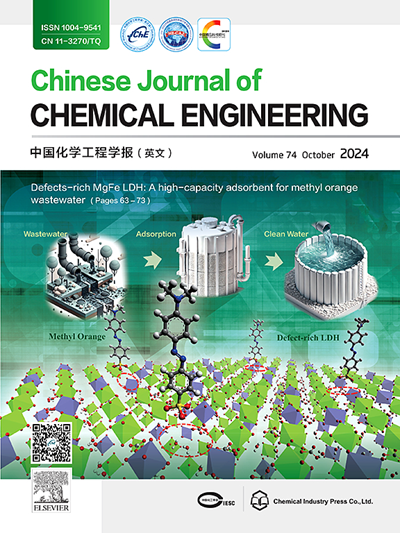Method and theory for optimising ash-fusion characteristics in high-aluminium coal ash via coal blending technology
IF 3.7
3区 工程技术
Q2 ENGINEERING, CHEMICAL
引用次数: 0
Abstract
China has abundant resources of high-alumina coal (HAC). However, its application as a raw gasification material is limited owing to high ash-fusion characteristics. For overcoming the limitation, this study employed Xinjiang coal (XJ), having a low ash fusion temperature, to improve the ash fusibility and viscosity of high-alumina Jungar coal (JG). The evolution of Al-containing phases and structures during mixed ash melting were investigated based on XRD, XPS, 27Al NMR, high-temperature stage microscopy (HTSM), and thermodynamic simulations. An increase in the XJ mass ratio resulted in the transformation of gehlenite to anorthite and mullite, producing more amorphous materials at high temperature. These phenomena were manifested at a microscopic imaging as an increase in the number of reaction/melting sites and their area expansion rate, as well as a decrease in ash area shrinkage and melting temperature. Moreover, the introduction of XJ altered the alumina–oxygen network, reducing the binding to the silica-oxygen network and converting some [AlO6]9− to [AlO4]5− as the relative concentration of O2− and O− increases. Consequently, the decrease in the stability of the aluminate structure improves the AFT and viscosity. Based on these results, a mechanism to improve the ash fusion characteristics of HAC based on coal blending is proposed.

配煤技术优化高铝煤灰灰融合特性的方法与理论
中国拥有丰富的高铝煤资源。然而,由于其高灰熔融特性,其作为气化原料的应用受到限制。为了克服这一局限,本研究选用灰熔融温度较低的新疆煤(XJ)来提高高铝准噶尔煤(JG)的灰熔融性和粘度。采用XRD、XPS、27Al NMR、高温阶段显微镜(HTSM)和热力学模拟等方法研究了混合灰熔融过程中含al相和结构的演变。XJ质量比的增加导致辉长石向钙长石和莫来石转变,在高温下产生更多的非晶态材料。这些现象在显微成像上表现为反应/熔点数量和面积膨胀率的增加,灰区收缩率和熔化温度的降低。此外,XJ的引入改变了氧化铝-氧网络,减少了与二氧化硅-氧网络的结合,并随着O2−和O−相对浓度的增加,将一些[AlO6]9−转化为[AlO4]5−。因此,铝酸盐结构稳定性的降低提高了AFT和粘度。在此基础上,提出了一种以配煤为基础改善混凝灰渣熔融特性的机理。
本文章由计算机程序翻译,如有差异,请以英文原文为准。
求助全文
约1分钟内获得全文
求助全文
来源期刊

Chinese Journal of Chemical Engineering
工程技术-工程:化工
CiteScore
6.60
自引率
5.30%
发文量
4309
审稿时长
31 days
期刊介绍:
The Chinese Journal of Chemical Engineering (Monthly, started in 1982) is the official journal of the Chemical Industry and Engineering Society of China and published by the Chemical Industry Press Co. Ltd. The aim of the journal is to develop the international exchange of scientific and technical information in the field of chemical engineering. It publishes original research papers that cover the major advancements and achievements in chemical engineering in China as well as some articles from overseas contributors.
The topics of journal include chemical engineering, chemical technology, biochemical engineering, energy and environmental engineering and other relevant fields. Papers are published on the basis of their relevance to theoretical research, practical application or potential uses in the industry as Research Papers, Communications, Reviews and Perspectives. Prominent domestic and overseas chemical experts and scholars have been invited to form an International Advisory Board and the Editorial Committee. It enjoys recognition among Chinese academia and industry as a reliable source of information of what is going on in chemical engineering research, both domestic and abroad.
 求助内容:
求助内容: 应助结果提醒方式:
应助结果提醒方式:


